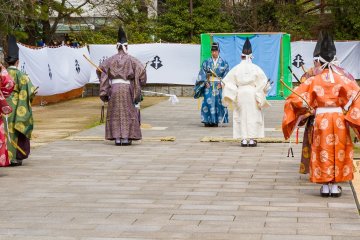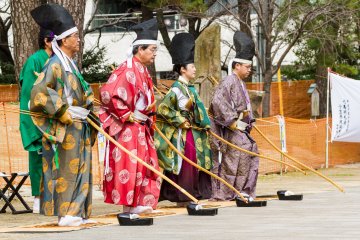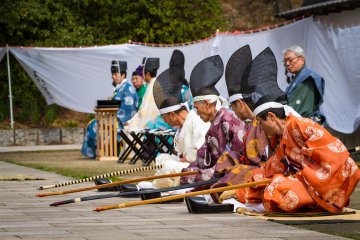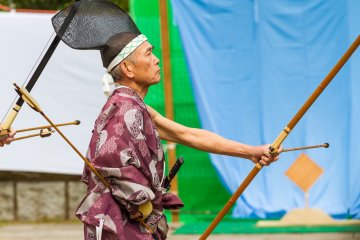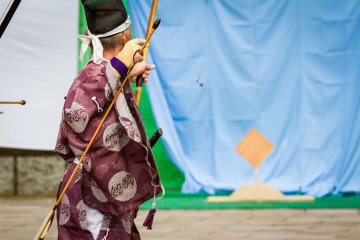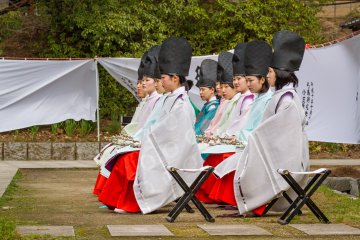The adventurous at heart might think the voyages of a traveler staying in one country for years would dwindle into something humdrum. They don’t need to—they can morph into experiences of complexity and maturity. Take today’s serendipitous entry into the world of the martial art of kyudo, or Japanese archery, on a visit to Kokura Castle.
I stumbled upon a gathering of people who had just stepped out of antiquity. Men and women in dignified, colorful dress gathered in front of the castle and its long history of samurai warriors, simple and refined architecture, and artistic gardens. In addition to seasonal events, like the cherry blossoms and days of snowfall that enhance the castle’s beauty, there are a number of festivals that make the grounds lively, and then there are other special occurrences like this one. With only a couple dozen spectators, everyone was right there in the action.
Knowing little about archery, I thought to absorb as much as I could from the demonstration then sort through the intricate details later. It looked familiar—bows and arrows—but from an alternate universe with archers expressing slow and measured movements in elegant robes, lacquered clogs, and tall mesh hats. I was in another time and place, but it was definitely not Robin Hood. Something interesting was happening, but it would take time to put it into words.
The following week, when I showed these photos to one of my students, Hibiki, I felt a deeper level of appreciation for my experience. He was just graduating high school and had been in the kyudo club. I discovered that rather than being about shooting arrows, what I had witnessed had, on another level, been the search for truth, goodness, and beauty—or what the Japanese call shinzenbi.
Hibiki came to life wanting to talk about the photos but also found frustration in attempting to explain them in detail—even with his high level of English. In high school, kyudo is a sport rather than a martial art. Teams compete for points in marksmanship and form rather than truth, goodness, and beauty. But this event was for kyudoka, masters of the martial art, where the competition is within the self and practice is an act of moral and spiritual development. Their understandings of shinzenbi were beyond what he could put into words, even in Japanese, for they had devoted a lifetime of study to the intricacies of this challenging art. Many Japanese do kyudo, but these individuals were some of the rare few who reach the higher ranks of the kyudoka.
Evolving from prehistoric times, Japanese archery reached new heights during the era after guns appeared, when monks turned the warrior aspect of archery from kyujitsu, the Skill of the Bow, into kyudo, the Way of the Bow.
The bow and arrow are known here as the yumi and the ya. Yumi are distinct form western bows, being very long and asymmetrical. The ya are fired at about a third of the way up the bow, which is well over 2 meters, or 7 feet, in length. Ya shafts are traditionally bamboo, with eagle or hawk feathers called hane used for fletchings. Archers shoot two ya in a round, with the three hane alternately curved clockwise (first arrow) and counterclockwise (second arrow). The feathers are taken from opposite sides of the bird and cause opposite spins that stabilize the arrows in flight. A glove is worn on the shooting hand (always the right hand), often having open ring and pinky fingers since these hold the second ya while the first is being fired.
The process of shooting of an arrow, known as the hassetsu (video), is usually divided into several distinct stages that flow seamlessly together. Because the ceremonial dress is bulky, archers will lower the garment from their left shoulder and shoot with a bare arm holding the yumi. From the initial footing through the draw, release, and lowering of the bow, all is conducted with skill and mindfulness. Even the entry into the venue, walking, and sitting was completed with ceremony.
On this day, the archers weren’t very successful in hitting the target. But I was nevertheless moved to be witness to their journey along the Way.
弓道—kyuudou—kyudo (traditional Japanese archery)







